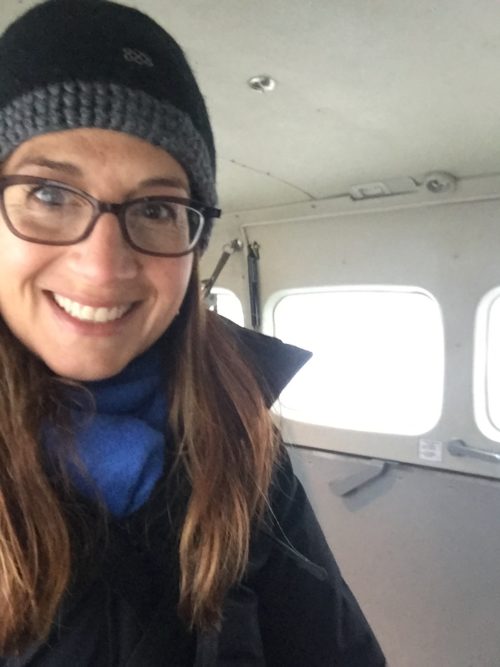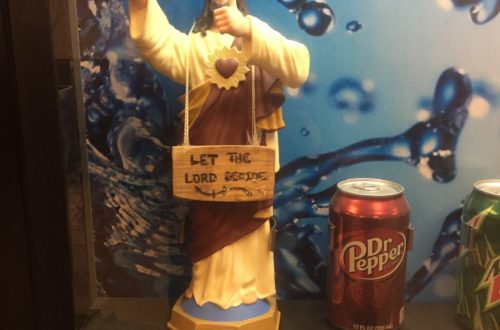
Anchorage and Kotzebue, Alaska (1/5)
My first glimpse of Alaska is from the airplane window and it is breathtaking. The white mountains look foreboding, distant and beckoning at the same time, like the Alaskan culture.
I am headed for a new optometric experience. I learned about this subculture of optometry when I posted a question on Facebook. “I am writing an article about unusual and interesting ways to practice optometry. Tell me yours.” One eye doctor described his business of sending optometrists to the bush of Alaska to examine native Alaskans. I wrote back, “I NEED to know more about this!”
In order to provide patient care in Alaska, I need an Alaskan license. (Optometry licenses are specific to each individual state.) In the months before the trip, I travel to Portland, OR to take a course on injectables, where they teach us to inject under the skin, into the muscle, and into the eye. Yes, INTO THE EYE! That freaks me out too. I take a 23-hour long online course on prescribing specific oral medications and pass a final test. With a few weeks to spare, my new license arrives in my mailbox.
On the ground, I retrieve my luggage and find my way to the hotel, which is across the street from a water plane park called Lake Hood. This airport is the world’s busiest seaplane base. I drop my bags in the room and, not wanting to waste a minute and fearing I will fall asleep if I stop moving, I head out to explore Anchorage. A frigid walk around the deserted-for-winter base to view the planes makes me want to spend some time indoors. Uber-ing downtown, I search for some lunch.
When traveling, I crave the experience of local food and flavors, so I look for a fresh, cold-water fish restaurant. The Glacier Brewhouse’s salmon salad was delicious but atypical compared to the salmon of the lower 48. This salmon is much more “real”, more flavorful, more earthy orange. It is textured more like tuna, drier and less oily than the salmon I am used to. I clean my plate.
Now warm, I head outside to hike a small part of the Coastal Trail. This paved walking, biking, and cross-country skiing path follows the coast of the Cook Inlet off the Gulf of Alaska. I enjoy walking along the water for about a mile until the cold and wind chill became prohibitive. Fingertips frozen, I walk to the Anchorage Museum.
I tour an art exhibition exploring the many forms of expression behind the things people enjoy in our culture. This international display includes examples like Hello Kitty, Harry Potter, Panic! at the Disco, Star Trek, Wonder Woman, Star Wars. I sleep walk through the creative expressions.
Back at my hotel and tired from being awake for 24 continuous hours, I drop off to sleep. My alarm is set for 3:45 am.
The next morning, I wake excited about this new experience. Only super cool things happen when you start your day at 4 am!! Also, I am unsettled and unsure, without enough information to be properly anxious. The unknown is hard to stress over. Monsters? Yes. Serial murderers? Yes. Unique new job in rural Alaska? Yes?
Julie is the optician for the company with whom I am contracted. She organizes and executes each monthly trip. She lives in Anchorage. She is fair, has blond hair and wears large, yellow, tiger-print glasses. Julie is strong from the years of lugging around hundreds of pounds of equipment. She is a talkative extrovert and will discuss anything with anyone. On this trip, she has the added burden of acquainting a green doc with the process of rural Alaskan travel and eye care.
The commercial flight to Kotzebue is uneventful. The OTZ airport has no heat, is a single room with a bathroom, and feels garage-like. We are crammed in the space, waiting for our luggage to appear on the metal slide entering from the tarmac. After gathering our luggage, we go next door to check-in for our next flight. Ravn is a private airline. Their airport is slightly larger than the commercial airport and is is heated with a vending machine. Because we have a few hours between flights, we store our bags and head back out into the cold.
We walk around Kotzebue carrying just our backpacks. We post flyers announcing the upcoming eye clinic in two grocery stores, two restaurants, the art center, the Lions Club, and the government buildings. The snow is falling swiftly, sticky and sideways, and is making walking difficult. We take advantage of the Chinese restaurant in town and get a tasty meal. Not knowing how my stomach will handle the upcoming flights, I get soup.
Kotzebue Sound is to our left and, if we had visibility more than two feet, maybe we could see Russia. The Bering Strait separates the continents. Although the Strait’s narrowest point is about 53 miles wide, there are two islands at its center, Little Diomede (US) and Big Diomede (Russia), which bring the distance between these two nations to only 2.5 miles apart at their closest point. In Kotzebue, I am 196 miles from Little Diomede, Russia.
The second leg of our flight is on a four-seater plane. I’m not sure if I will be troubled by the tiny planes. My first flight on these machines that simulate cars with wings is fascinating. I am seated directly behind the pilot. If I wanted to, I could reach out between the seats and touch the co-pilots steering mechanism. I watch the pilot carefully and calmly. It is odd to see the pilot move the steering column and then feel the responsive shift of the weight of the plane. In reality, I feel less danger and more control with the small planes than the large commercial ones. If we were going down, it seems that the pilot has more resources to save us. Acclimated, I take grinning selfies to send to my family.
It is 10 am. The scenery is otherworldly with the sun rising on the horizon. The orange ombre sky with the swirling ice patterns below comprises such an unusual landscape that all I can do is stare. In the end, the flight is very peaceful and I arrive in Noorvik refreshed.


You May Also Like

Sad Alaska (4/5)
January 25, 2018
Happy Alaska (5/5)
January 26, 2018
